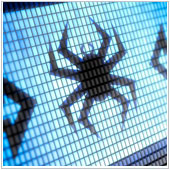
Here are five tips you can share with your employees about how to keep systems free from malware.
1. Don’t turn off or stop your anti-virus scanner
There is little doubt as to the usefulness of your anti-virus scanners. The scanners are installed to keep systems free from viruses and malware. Because there is a constant stream of new pieces of malware being developed and released, the companies that run the antivirus scanners keep their databases as up-to-date as possible. It is these databases that are pushed to users in weekly or daily updates. Therefore, it is imperative to keep your virus-scanner enabled and updated, to increase the chances of it picking up newer and more serious malware.
If your scanner attempts to run during business hours, some systems may slow down. To avoid this, adjust the scanner to run at a time when you aren’t at your desk, say after 5:00 pm, or early in the morning. Work with your IT partner to plan your virus-scanning schedule.
An important factor to remember is that if you don’t run your anti-virus scanner, or turn off your scanning software, the chances of your computers being infected increases exponentially.
2. Watch what you download
One of the more common ways malicious software makes it onto computers is through downloaded files. That Facebook toolbar that a website is advertising as a must-have, or the file that must be downloaded in order to watch a movie online, may actually be teeming with viruses.
Therefore, you should only download files from websites that you know are secure and offer legitimate files. And, before you download anything, ask yourself, “Do I really need this, and will I really use it?” If you are unsure, check with a colleague, or reach out to your IT partner.
3. Study email attachments closely
Another common way malicious software and viruses spread is through email attachments. Sometimes an email account has been compromised and a hacker is sending emails to users with the virus attached, or the host system has been infected and the virus is essentially sending itself. Regardless of how the email is being initiated, you should be wary of all email attachments.
Before you open ANY attachment, verify that it is actually referenced in the email, that it is the file referenced, and that the name is logical. If you see an email that states a document or file is attached, take a look at the name of the attached file. If it ends in .exe or .dmg, this is a program and likely a virus, and should not be opened. You should also look at who is sending the email to you. If you don’t know the sender, it is recommended that you do not open the attachment. If you are unsure, try contacting the sender via another email message.
4. Avoid using shared disks when possible
While external hard drives and thumb drives may be incredibly useful, they can spread viruses. If a USB drive is carrying an infected file, it can infect the system when the file is opened.
If you do use shared drives, check them with your virus scanner before accessing them. When you plug in a drive, before you open any files or even the drive itself, right click on it and you should see an option to scan the drive with your virus scanner. If not, you can likely do this from the virus scanner itself. This will take extra time, but it will help keep your systems secure.
5. Ask yourself whether you really need to have an administrator account for Windows
On many systems, when you set up a new user, you can set the account to have administrator privileges on that system. Administrators by default have the ability to install programs, change settings, and create new accounts. If you don’t need to change your computer’s settings or install programs then you likely don’t need to have an administrator account. This can be a great way to minimize virus infections, simply because the viruses need to be installed to do any damage. If you can’t install programs or even download them, then your chances of being infected are lower.

